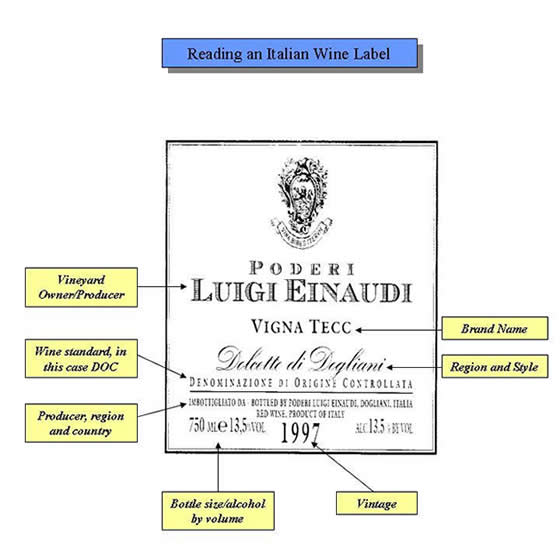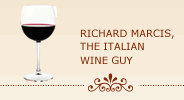decoding an Italian Wine label
Italian wine labels have a lot of information on them critical to understanding what's in the bottle. It is an appelation-based system in that the specific information on a wine label is determined by the specific appelation's quality level rules and regulations. The label below for a Dolcetto di Dogliani producer is a good example of the information contained on a label for an appelation wine:
i
Aside from these descriptions, there are some additional terms you may find on wine labels that indicate wine quality:
- The term Classico can be added after the description of where the wine is made to indicate that the wine was made in the historic center of a wine-producing area such as Valpolicella Classico or Chianti Classico.
- Superiore indicates that a wine has a higher alcohol level, typically at least 0.5 percent higher, than an otherwise equivalent wine from that area. It may also include restrictions on vineyard yields and additional ageing requirements.
- The term Riserva indicates that the wine has been aged longer, usually a year longer, than an otherwise equivalent wine from that area or region with a two year minimum ageing.
Wine classifications are also indicated on wine labels. The Italians have strict controls on their wines with regulations to ensure origin, inherent quality, and authenticity. While based on France's Appellation d'origine controllee (AOC) system that specifies production area and methods for each wine, Italy's wine classification system goes one step further in that it guarantees the quality standard of wines. These label classifications help consumers determine where the wine comes from and the quality of the wine they are purchasing.
The categories of Italian wines are:
Vino da Tavola Indicates an ordinary table or generic wine that provides the producer with considerable flexibility in terms of what information to provide on the label. These wines do not have to specify the grape variety, vintage or place of origin on their label and do not conform to DOC regulations on grape types or vinification techniques.
IGT — Indicazione Geografica Tipica This appellation was established after the DOC and DOCG designations were created in order to accommodate growers who for one reason or another couldn't - or didn’t want to - meet the requirements for DOC or DOCG designation. This designation permits producers greater flexibility in both vineyard management and cellaring procedures in crafting wines that are considered to be of higher quality than simple table wines (Vino da Tavola). Were it not for this category, world-class Super-Tuscan wines such as Tignanello and Sassicaia, among others, would otherwise be classified as simple Vino da Tavola wines.
DOC — Denominazione di Origine Controllata Literally, it translates as controlled denomination of area. It denotes a specific type of wine with controls on the area in which the grapes must be grown usually with other specifications for grape varieties, color, aroma, flavor, alcohol content, acidity, aging procedures and/or period of aging.
DOCG — Denominazione di Origine Controllata e Garantita Literally, it translates as controlled denomination of area and guaranteed. This is the premier classification for Italian wines (see exception below). More stringent standards are imposed for DOCG wines than DOC wines such as lower yield requirements on vineyards, submitting wines for taste tests by tasting panels and to in-depth chemical analyses before bottling.
All DOCG wines (and some DOC wines) have a paper band that wraps around the neck of the bottle with a serial number as a sign of authenticity.
Chianti Classico "Gran Selezione" This a new level of Chianti Classico DOCG wines that resides at the top of the Chianti Classico quality pyramid. Officially approved in February 2014, Gran Selezione (Grand Selection) requires stricter production standards. Gran Selezione wines must be made exclusively with grapes from the estate's own vineyards and must meet upgraded requirements for alcohol (minimum 13 percent); extract (minimum 26 grams per liter); ageing (minimum 30 months that includes 3 months in the bottle); and contain a minimum of 80 percent Sangiovese .
Richard Marcis
Updated August 2, 2021
Help keep this website ad-free and independent.
Consider making a contribution to support the work of WineWordsWisdom.com.


